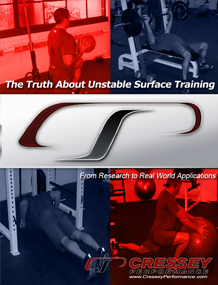
5 Important Lessons on Balance Training
You’ll hear the terms “stability” and “balance” thrown around a lot in the personal training, strength and conditioning, and rehabilitation communities, but they’re often covered in very vague terms – and with hastily thrown together exercise progressions. Let’s cover some things you need to appreciate to be more informed in this regard.
1. Balance and stability are not the same thing.
In Basic Biomechanics, Susan Hall (2003) defined stability as “resistance to both angular and linear acceleration, or resistance to disruption of equilibrium.” Conversely, she defined balance as “the ability to control equilibrium” or “the process of maintaining the center of gravity within the body’s base of support within a given sensory environment.”
In other words, stability is a state, and balance is a proficiency. Your level of stability is constantly changing based on environmental factors, external influences working on you, and your positioning. Balance is something you have (or lack) to varying degrees; neural factors such as muscular strength, kinesthetic awareness, coordination, and proprioception all contribute to one’s balancing proficiency.
In training, we often reduce stability (e.g., go to unilateral instead of bilateral stance) in order to train to improve our balancing proficiency.
2. Static and dynamic balance are only loosely correlated.
All the way back in 1967, Drowatzky and Zuccato observed little carryover from static to dynamic balance skills, and it was proven again decades later by Tsigilis. With that in mind, it makes sense to train a “continuum” of balance challenges ranging from static to dynamic:
3. Balance is an easy and “free” adaptation to acquire.
If you watch all of the exercises I just outlined along that static-to-dynamic continuum, none of them are particularly taxing. In other words, they can be trained every day without having to remove a lot of other stuff from your programs out of concern for exceeding recovery capacity. The best way to improve balance is to train it frequently and with small exposures, even if it’s as simple as telling athletes to brush their teeth on one foot. Nobody will overtrain on balance work.
4. Balance is skill specific.
Having great balance on hockey skates doesn’t mean that you’ll have elite balance on a basketball or tennis court. This is why it’s so important to challenge balance in a variety of ways (by manipulating stability scenarios) in training; it increases the likelihood of “overlap” to the chaos that athletic participation throws at us.
5. Unstable surface training is simply one means of modifying stability in a given situation – but that doesn’t mean that it’s an appropriate or safe method of training balance.
I spent two years of my life studying unstable surface training (UST) for my master’s thesis, which was published in the Journal of Strength and Conditioning Research in 2007. Suffice it to say that there are a few scenarios in which UST can be very useful, most notably the rehabilitation of functional ankle instability. Usually, however, other avenues of stability manipulation are much better ways to enhance balance.
With that in mind, if you’d like to learn more about not only unstable surface training, but all the different ways you can alter stability to enhance balance in your training programs, I’d strongly encourage you check out my e-book, The Truth About Unstable Surface Training.




